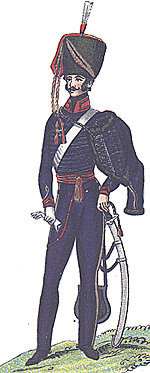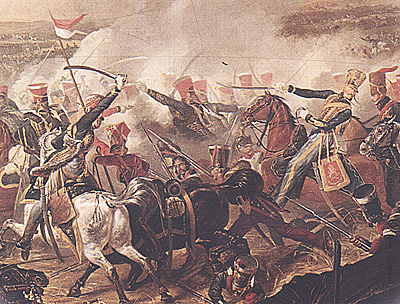Left Wing History:
Waterloo 1815
Early Action
by Gary Cousins, Germany
| |
In the early afternoon, the French I Corps under D’Erlon advanced and attacked the left of Wellington’s position. Officer of the 1st Hussars of the K.G.L. By Rittmeister Graf Castell Dyneley recalled that some of the artillery with Vivian’s Brigade came into action around this time: “Little was done on either side till about twelve o'clock, when they brought their artillery forward, deployed into line, and opened about 40 pieces upon us at once. The rascals certainly did this beautifully, at the same time sending a very strong body of infantry, supported by their cuirassiers, on our centre. I went with a couple of guns and peppered away at them until the Life Guards charged…” [18]
Ingilby said that the two guns which went forward were his, and that since both Vivian and Gardiner also went with him and Dyneley, they were “…pretty sufficiently commanded you will remark ...” [19]
D’Erlon’s attack was brought to an end by the first major cavalry action of the day, the charge of the British heavy brigades. The outcome of this charge is well known, although who initiated it is by no means clear.
Certainly Uxbridge hurried across from the right, set both the Household and Union Brigades in motion, and led the charge, as his own accounts stated.
[20]
However, one authority has suggested that Uxbridge “…certainly led it, but is unlikely to have ordered it without permission, considering what we know of Wellington's long record in combat…”;
[21] but as Uxbridge’s descendant and biographer has
said: “There is very little evidence as to how much and in exactly what manner Wellington interfered in the movements of the cavalry during the battle.” [22]
Uxbridge himself was adamant that:
“…I received no order from the Duke of
Wellington to make the first charge or any
other during the day…
…I felt that he had given me carte blanche, and I never bothered him with a
single question respecting the movements it
might be necessary to make…” [23]
There is even doubt about whether Wellington
actually saw the charge, [24] although
Fitzroy Somerset said that Wellington came
across to the centre of the line in time to see
the attack on Picton’s Division; [25] and Uxbridge
wrote that, after the charge:
“When I was returning to our position I
met the Duke of Wellington, surrounded by all
the Corps diplomatique militaire, who had
from the high ground witnessed the whole
affair. The plain appeared to be swept clean,
and I never saw so joyous a group as was this
Troupe dorée. They thought the Battle was over.” [26]
One result of the charge was that, for the heavy brigades, the battle was practically over: and Wellington remarked (perhaps ironically): “Well, Paget, I hope you are satisfied with your cavalry now.” [27]
However Uxbridge may have felt about
the charge at the time, upon later reflection he
regretted leading the charge personally, and
the failure of his “second line” – although he
seems to have ordered the heavy brigades to
operate a reserve, and he believed that the
orders he had given to the light brigades of
Vivian and Vandeleur empowered them to
offer timely support. [28]
Another general supposedly encouraged
the light brigades to become involved in this
episode. Generalmajor Graf von Müffling, the
Prussian liaison officer attached to
Wellington’s headquarters, recalled in his
memoirs:
I arrived on the left wing at the same
moment that General Picton (who fell on this
occasion) was repulsed in his attack on the
enemy's 1st corps...
…Two brigades of English cavalry, of
three regiments each, stood on our left wing; I
urged the commanders [Vivian and Vandeleur]
of both to cut in upon the scattered infantry,
observing that they could not fail to bring back at least 3000 prisoners. Both agreed with
me fully, but, shrugging their shoulders, answered: “Alas, we dare not! The Duke of Wellington is very strict in enforcing obedience to prescribed regulations on this point….
…I had afterwards an opportunity of asking
the Duke about these regulations, which I
could do the more freely, as the two officers in
question were amongst the most distinguished
of the army, and had rendered the most signal
services with their brigades in the action that day.
The Duke answered me: “The two generals were perfectly correct in their answer, for had they made such an onslaught without my permission, even though the greatest success had crowned their attempt, I must have brought them to a court-martial; for with us it is a fixed rule, that a general placed in a pre-arranged position, has unlimited power to act within it, according to his judgment: for instance, if the enemy assails him, he may defend himself on the spot, or meet the enemy from a covered position; and in both cases he may pursue them, but never further than the obstacle behind which the position assigned him lay; in one word, such obstacle, until fresh orders, is the limit of his action. ” [29]
An arrangement whereby Wellington “referred his generals of the left wing” to Müffling may have made sense, and it has been speculated that, much later in the day,
“…Wellington may have given unofficial command of the Allied forces on his left to the Prussian General Müffling, an able commander and a man of considerable professional ability and diplomacy...”, who “…undertook no actual direction of combat forces, but was certainly instrumental in bringing the Prussians more quickly into the battle than would otherwise have been possible ...”
[30]
Indeed, one authority accepted that such an arrangement was made early on in the day, and accounted for Vandeleur’s unenthusiastic response by suggesting that he was perhaps “…a soldier who, however brave, was more accustomed to wait for orders than to act on his own initiative. He had served for a long time under the Duke of Wellington, and knew how heavily he could vent his displeasure on
officers who moved without orders ...”, and that “…freedom of action was not well established in his mind at the time the aid of his brigade was most required …”; [31] which may be unfair on Vandeleur, since, if Müffling is to be believed, Vivian was equally timid.
A difficulty with such ideas is that none of Wellington’s generals ever mentioned any arrangement whereby they were referred to Müffling, and neither Vivian nor Vandeleur ever mentioned having a
discussion with Müffling during this episode. The only person who seemed to know about the general arrangement and the specific discussion was Müffling himself. It has also been suggested that Müffling rode away after Vivian and Vandeleur declined his proposal -- after which, and thus without Müffling’s knowledge, Vandeleur changed his mind, and decided to advance after all [32] -- thus explaining away the other difficulty for Müffling’s story, which is the fact that Vivian’s and Vandeleur’s Bri-gades on the left did become involved in the aftermath of the charge of the heavy brigades.
When D’Erlon’s attack had achieved some early success, and Picton’s infantry had closed to the right to fill up gaps, Vandeleur received an order (he was unsure from who it came) to close to his right, and as a result he saw the Ponsonby’s Brigade withdrawing in some difficulty.
A part of Vandeleur’s Brigade, and at least part of Major-General Baron de Ghigny’s Netherlands 1st Light Cavalry Brigade, went forward to assist. Vandeleur’s 12th and 16th Light Dragoons advanced “as quickly as was consistent with order” through Best’s Brigade (leaving the 11th Light Dragoons in reserve) - to attack, not (at least ostensibly) the scattered infantry, as apparently suggested by Müffling, but the fresh French cavalry threatening Ponsonby’s Brigade. [33]
This action was not witnessed, or must have been forgotten, by Wellington, according to the comments he apparently made to Müffling. [34]
Afterwards Vandeleur’s Brigade returned to the interior slope of the position, but more to the right of where it had earlier been stationed. [35]
But perhaps in fact Vandeleur was more enthusiastic that Vivian. For although Vivian went forward to observe the events in the valley below; and even prepared to advance, sending word back to the 10th and 18th Hussars to move through the hollow way to their right, leaving the 1st Hussars of the K.G.L. to keep a lookout to the left; [36] yet his hussars did not come into action on this occasion, as Vandeleur recalled:
“Sir Hussey Vivian's Brigade followed Vandeleur's over the ravine, but could not arrive in time to cover the retreat of Sir William Ponsonby's Brigade. It formed on the left of the ground from which Vandeleur's had charged. The pass across the ravine was narrow and required some time to pass, which was the reason that Sir J. Vandeleur left the 11th in reserve.”
[37] However, according to Ingilby, Vivian did not become involved because he was mindful of the orders he received earlier from Wellington through De Lancey -- not to become engaged, and to keep the Brigade intact until the Prussians arrived -- as overheard by Ingilby; and Ingilby also related how his own foray into action ended when a French shell blew up one of his ammunition boxes ... [38]
After this episode, the 10th and 18th Hussars continued in their new position, on the right of the lane to Verd-cocou, but now somewhat separated from the 1st Hussars of the K.G.L. [39]
There was no significant movement or action for Vivian’s Brigade for the rest of the afternoon, and the only casualties were from the cannonade and skirmish fire -- for its main role for this period was as a look-out for the Prussians.
Left Wing History Waterloo 1815: Vivian's 6th Cavalry Brigade
Left Wing History (2) Prussian I Corps
|


 “... a serious attack commenced on the
left. This was the most dangerous point, on
account of the connection with the Prussian
army; and as I could be of most use there in
directing, on their arrival, the Prussian troops,
who were totally unacquainted with the field
of battle, the Duke wished me to proceed
thither, and at the same time to take care that
his left wing acted in full concert with the
Prussian army. With this view he referred his
generals of the left wing to me.
“... a serious attack commenced on the
left. This was the most dangerous point, on
account of the connection with the Prussian
army; and as I could be of most use there in
directing, on their arrival, the Prussian troops,
who were totally unacquainted with the field
of battle, the Duke wished me to proceed
thither, and at the same time to take care that
his left wing acted in full concert with the
Prussian army. With this view he referred his
generals of the left wing to me.